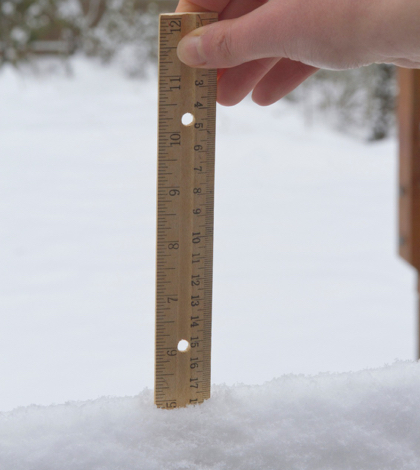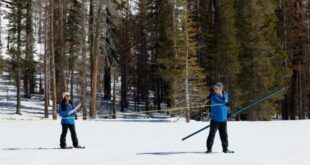The Department of Water Resources (DWR) conducted the fourth manual snow survey of 2020 yesterday at Phillips Station. Due to the ongoing COVID-19 pandemic, DWR provided a video of the results in lieu of conducting a live media event on site.
Yesterday’s manual survey recorded 43.5 inches of snow depth and a snow water equivalent (SWE) of 16.5 inches, which is 66 percent of the April average for this location. Measurements from the 130 electronic snow sensors, scattered throughout the state, indicate that the statewide snowpack’s water equivalent is 15.2 inches, or 53 percent of the April average.
In addition to the manual snow surveys and automated snow measuring sites, DWR is collaborating to augment the measurements with satellite and air-borne remote-sensed data. These experimental data products provide additional detail to the spatial patterns of snow water accumulation in the watersheds that helps inform and guide forecast runoff quantities and timing. Such data gathering will be a key adaptation strategy as climate change impacts continue to mount.
“While today’s survey results show our snowpack is better off than it was just last month, they still underscore the need for widespread, wise use of our water supplies,” said DWR Director Karla Nemeth. “California’s climate continues to show extreme unpredictability, and February’s record dryness is a clear example of the extremes associated with climate change.”
California is experiencing increased extremes and variability due to climate change. In one year, California has gone from having the fifth best recorded snowpack to one of the 10 worst.
“Over the last decade, California’s snowpack has been alternating between extremely wet and extremely dry,” stated Sean de Guzman, chief of DWR’s Snow Survey and Water Supply Forecast Section. “In the past 10 years, we’ve seen three of our smallest snowpacks on record, but we’ve also seen three of our largest snowpacks on record.”
On average, the snowpack supplies about 30 percent of California’s water needs as it melts in the spring and early summer.
The state’s six largest reservoirs currently hold between 82 percent (San Luis) and 125 percent (Melones) of their historical averages for this date. Lake Shasta, California’s largest surface reservoir, is 98 percent of its historical average and sits at 79 percent of capacity.
 California Water News Daily Your Source For Water News in California
California Water News Daily Your Source For Water News in California


